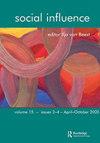Using regulatory fit theory to examine how the communication context of compliance-gaining interactions influences compliance
IF 0.6
3区 心理学
Q3 PSYCHOLOGY, SOCIAL
引用次数: 1
Abstract
Abstract Compliance-gaining research focuses mainly on how message variations differentially affect compliance; however, few studies have examined how framing the compliance-gaining goal (i.e., promotion/prevention) and providing a means to achieve the goal function concurrently to influence compliance. The current study uses regulatory fit theory to examine how a fit between goals and means of compliance-gaining messages affects compliance. A field experiment was conducted in which subjects were presented with a compliance-gaining request in which goals and means were varied. Results indicated that compliance rates and donation amounts were higher under conditions of fit between the regulatory orientation of goals and means rather than non-fit. Findings are discussed in light of their implications for compliance-gaining research and regulatory fit theory.运用法规契合理论研究获得合规性的沟通环境如何影响合规性
符合性获取的研究主要集中在信息变化对符合性的影响上;然而,很少有研究探讨如何制定获得合规的目标(即促进/预防)并提供实现目标功能的手段同时影响合规。当前的研究使用监管契合理论来研究目标和手段之间的契合如何影响合规。进行了一项实地实验,在实验中,受试者被提出了一个获得服从的要求,其中目标和手段是不同的。结果表明,在目标导向与手段相匹配的条件下,捐赠金额和合规率高于不匹配的条件。研究结果讨论了他们的影响,以合规获得研究和监管契合理论。
本文章由计算机程序翻译,如有差异,请以英文原文为准。
求助全文
约1分钟内获得全文
求助全文
来源期刊

Social Influence
PSYCHOLOGY, SOCIAL-
CiteScore
1.50
自引率
0.00%
发文量
4
期刊介绍:
Social Influence is a journal that provides an integrated focus for research into this important, dynamic, and multi-disciplinary field. Topics covered include: conformity, norms, social influence tactics such as norm of reciprocity, authority, scarcity, interpersonal influence, persuasion, power, advertising, mass media effects, political persuasion, propaganda, comparative influence, compliance, minority influence, influence in groups, cultic influence, social movements, social contagions, rumors, resistance to influence, influence across cultures, and the history of influence research.
 求助内容:
求助内容: 应助结果提醒方式:
应助结果提醒方式:


